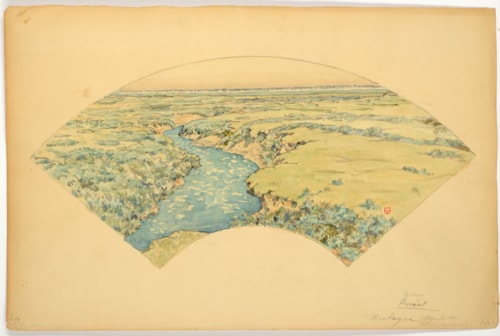
George AURIOL
Beauvais 1863 - Paris 1938
Biography
An artist, typographer, critic, poet, composer and singer who worked under the pseudonym of George Auriol, Jean-Georges Huyot began his career as a writer, and in 1885 became the editor of the anti-establishment satirical journal Le Chat Noir, which was closely associated with the Montmartre cabaret of the same name. Auriol composed a number of songs for the Chat Noir, where he met and befriended the artists Henri Rivière, Théophile-Alexandre Steinlen and Antonio de La Gándara, as well as the French satirist and political cartoonist Emmanuel Poiré, known as Caran d’Ache, and the Greek poet and critic Jean Moréas. In 1893 he exhibited for the first time in public at the Société des Peintres-Graveurs at the Galerie Durand-Ruel in Paris, and four years later was among the artists selected by the print publisher Ambroise Vollard to contribute to his L’Album des peintres-graveurs and L’Album d’estampes originales de la Galerie Vollard. Auriol also provided illustrations for such periodicals as L’Estampe and L’Affiche and the publishers Hachette, Larousse and Enoch. His love of flowers as decorative motifs found its way into many of his designs for lithographic illustrations, posters, sheet music covers, menus and theatre programmes, while he also designed the lettering on many Belle Epoque posters, typified by La Gitane, drawn by Henri de Toulouse-Lautrec in 1899.
Around 1901 Auriol began working as a typographer, designing a number of Art Nouveau-inspired fonts and typefaces, of which the most famous - named the ‘Auriol’ after the artist - was used by the architect Hector Guimard for the signage on the stations of the Paris Métro. Auriol created several distinctive typefaces, including Française-légère, Française-allongée, Auriol-labeur and Auriol-champlevé, and also published three books of designs à la Japonaise for stamps and monograms. Auriol’s lifelong affinity for Japanese aeshetics, and the influence of Japanese art on much of his work, led the contemporary art critic and writer Arsène Alexandre to refer to the artist as ‘Un Japonais de Paris’. Auriol ended his career as a teacher of drawing at the Ecole Estienne, where he was employed from 1924 onwards, and died at the age of seventy-five.


